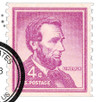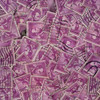
# 1058 - 1958 4c Abraham Lincoln, coil
1958 4¢ Abraham Lincoln
Liberty Series Coil
City: Mandan, North Dakota
Quantity: Unknown
Printed by: Bureau of Engraving and Printing
Printing Method: Rotary Press
Perforations: 10 Horizontally
Color: Red Violet
Lincoln’s Cooper Union Address
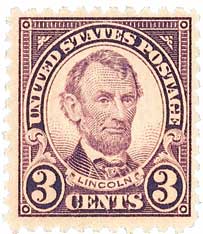
On February 27, 1860, Abraham Lincoln gave one of the most important speeches of his career – the Cooper Union Address.
By late 1859, there were several contenders in the running for the following year’s presidential race. The Republican expected to win at that point was William Seward, though many in his party thought he might not be electable.
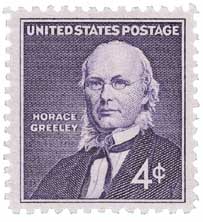
So the Young Men’s Republican Union, whose members included Horace Greeley and Hamilton Fish, invited a group of more moderate candidates to address a New York audience. Among the choices were Frank Blair, Cassius Clay, and Abraham Lincoln. Lincoln knew full well that his speech, if successful, could lead to a nomination, and even the presidency.
In preparing for the speech, Lincoln’s then-law partner William Herndon noted, “No former effort in the line of speech-making had cost Lincoln so much time and thought as this one.” Lincoln recognized that this speech could have a great impact upon his campaign for the presidency, and “searched through the dusty volumes of congressional proceedings in the State library, and dug deeply into political history. He was painstaking and thorough in the study of his subject.”
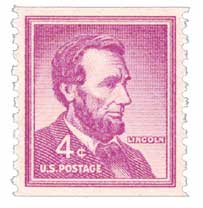
The focus of Lincoln’s speech was slavery. He spent months researching to prove that the framers of the Constitution believed that the federal government should regulate the adoption of slavery in new territories.
Initially, Lincoln’s speech was to be at Henry Ward Beecher’s church in Brooklyn. But when he arrived in New York City, he found that the event was moved to the Cooper Institute in Manhattan. Then on the unseasonably warm night of February 27, 1860, Lincoln addressed an audience of more than 1,500 New Yorkers at the Cooper Union. Many were initially shocked at his appearance. One person present that day recalled, “When Lincoln rose to speak, I was greatly disappointed. He was tall, tall, – oh how tall! And so angular and awkward that I had, for an instant, a feeling of pity for so ungainly a man.”
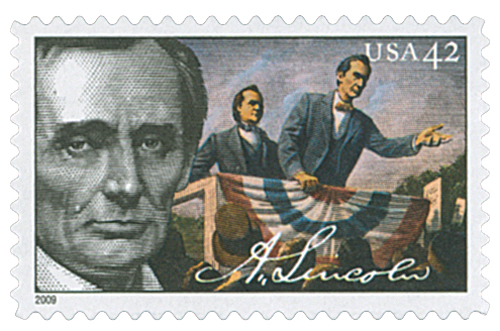
But Lincoln’s audience embraced him once he got started and “his face lighted up as with an inward fire; the whole man was transfigured. I forgot his clothes, his personal appearance, and his individual peculiarities. Presently, forgetting myself, I was on my feet like the rest…cheering for this wonderful man.”
For more than an hour, Lincoln captivated his audience with an electrifying 7,500-word speech. The next day, his speech was printed in papers throughout New York City with one reporter exclaiming, “No man ever before made such an impression on his first appeal to a New York audience.”
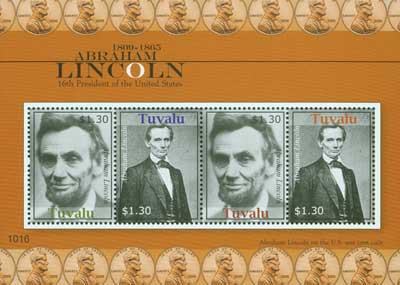
With this speech, Lincoln established himself as a frontrunner in the Republican Party, easily securing the party’s presidential nomination just three months later.
Click here to read Lincoln’s Cooper Union Address.
1958 4¢ Abraham Lincoln
Liberty Series Coil
City: Mandan, North Dakota
Quantity: Unknown
Printed by: Bureau of Engraving and Printing
Printing Method: Rotary Press
Perforations: 10 Horizontally
Color: Red Violet
Lincoln’s Cooper Union Address

On February 27, 1860, Abraham Lincoln gave one of the most important speeches of his career – the Cooper Union Address.
By late 1859, there were several contenders in the running for the following year’s presidential race. The Republican expected to win at that point was William Seward, though many in his party thought he might not be electable.

So the Young Men’s Republican Union, whose members included Horace Greeley and Hamilton Fish, invited a group of more moderate candidates to address a New York audience. Among the choices were Frank Blair, Cassius Clay, and Abraham Lincoln. Lincoln knew full well that his speech, if successful, could lead to a nomination, and even the presidency.
In preparing for the speech, Lincoln’s then-law partner William Herndon noted, “No former effort in the line of speech-making had cost Lincoln so much time and thought as this one.” Lincoln recognized that this speech could have a great impact upon his campaign for the presidency, and “searched through the dusty volumes of congressional proceedings in the State library, and dug deeply into political history. He was painstaking and thorough in the study of his subject.”

The focus of Lincoln’s speech was slavery. He spent months researching to prove that the framers of the Constitution believed that the federal government should regulate the adoption of slavery in new territories.
Initially, Lincoln’s speech was to be at Henry Ward Beecher’s church in Brooklyn. But when he arrived in New York City, he found that the event was moved to the Cooper Institute in Manhattan. Then on the unseasonably warm night of February 27, 1860, Lincoln addressed an audience of more than 1,500 New Yorkers at the Cooper Union. Many were initially shocked at his appearance. One person present that day recalled, “When Lincoln rose to speak, I was greatly disappointed. He was tall, tall, – oh how tall! And so angular and awkward that I had, for an instant, a feeling of pity for so ungainly a man.”

But Lincoln’s audience embraced him once he got started and “his face lighted up as with an inward fire; the whole man was transfigured. I forgot his clothes, his personal appearance, and his individual peculiarities. Presently, forgetting myself, I was on my feet like the rest…cheering for this wonderful man.”
For more than an hour, Lincoln captivated his audience with an electrifying 7,500-word speech. The next day, his speech was printed in papers throughout New York City with one reporter exclaiming, “No man ever before made such an impression on his first appeal to a New York audience.”

With this speech, Lincoln established himself as a frontrunner in the Republican Party, easily securing the party’s presidential nomination just three months later.
Click here to read Lincoln’s Cooper Union Address.








